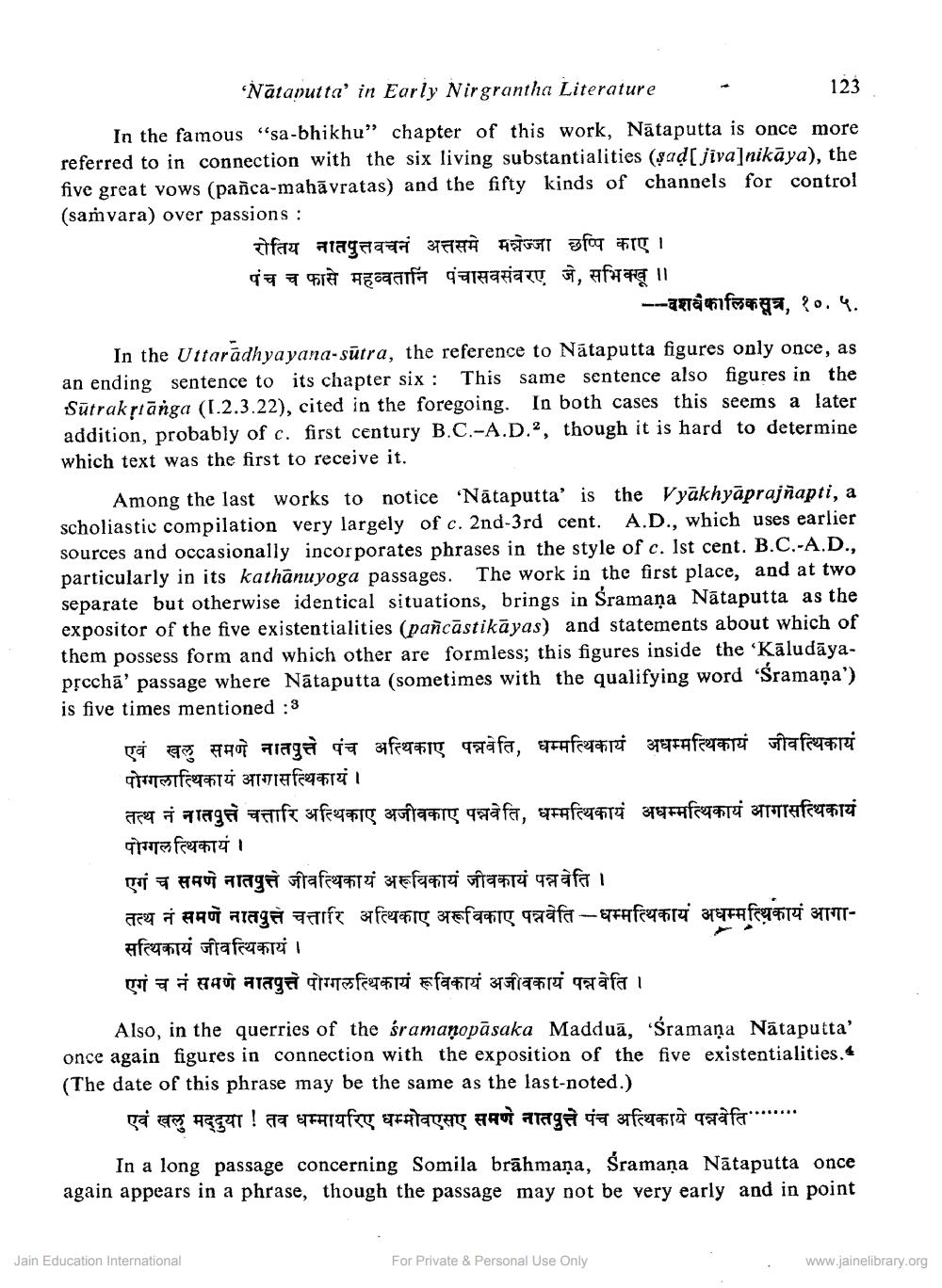Book Title: Nataputta in Early Nirgrantha Literature Author(s): M A Dhaky Publisher: Z_Aspect_of_Jainology_Part_3_Pundit_Dalsukh_Malvaniya_012017.pdf View full book textPage 4
________________ 'Nātanutta' in Early Nirgrantha Literature 123 In the famous "sa-bhikhu" chapter of this work, Nataputta is once more referred to in connection with the six living substantialities (sad[ jīva]nikāya), the five great vows (panca-mahāvratas) and the fifty kinds of channels for control (samvara) over passions : रोतिय नातपुत्तवचनं अत्तसमे मन्नेज्जा छप्पि काए । पंच च फासे महव्वतानि पंचासवसंवरए जे, सभिक्खू ।। --वशवकालिकसूत्र, १०. ५. In the Uttaradhyayana-sūtra, the reference to Nātaputta figures only once, as an ending sentence to its chapter six : This same sentence also figures in the Sutrakrtanga ([.2.3.22), cited in the foregoing. In both cases this seems a later addition, probably of c. first century B.C.-A.D.”, though it is hard to determine which text was the first to receive it. Among the last works to notice "Nātaputta' is the Vyākhyāprajñapti, a scholiastic compilation very largely of c. 2nd-3rd cent. A.D., which uses earlier sources and occasionally incorporates phrases in the style of c. Ist cent. B.C.-A.D., particularly in its kathānuyoga passages. The work in the first place, and at two separate but otherwise identical situations, brings in Šramaņa Nātaputta as the expositor of the five existentialities (pañcāstikāyas) and statements about which of them possess form and which other are formless; this figures inside the 'Kāludāyaprcchā' passage where Nātaputta (sometimes with the qualifying word 'Sramaņa') is five times mentioned :3 एवं खलु समणे नातपुत्ते पंच अस्थिकाए पनवेति, धम्मत्यिकायं अधम्मत्थिकायं जीवत्थिकायं पोग्गलात्थिकायं आगासत्थिकायं । तत्थ नं नातपुत्ते चत्तारि अस्थिकाए अजीवकाए पन्नवेति, धम्मत्थिकायं अधम्मत्थिकायं आगासत्थिकायं पोग्गल त्थिकायं। एगं च समणे नातपुत्ते जीवत्थिकायं अरूविकायं जीवकायं पन्नवेति । तत्थ नं समणे नातपुत्ते चत्तारि अत्थिकाए अरूविकाए पनवेति-धम्मत्थिकायं अधम्मत्थिकायं आगासत्थिकायं जीवत्यिकायं । एगं च नं समणे नातपुत्ते पोग्गलत्थिकायं रूविकायं अजीवकायं पन्नवेति । Also, in the querries of the sramanopāsaka Maddua, Sramana Nataputta' once again figures in connection with the exposition of the five existentialities. (The date of this phrase may be the same as the last-noted.) एवं खलु मदुया ! तव धम्मायरिए धम्मोवएसए समणे नातपुत्ते पंच अत्थिकाये पन्नवेति......" In a long passage concerning Somila brāhmaṇa, Sramana Nātaputta once again appears in a phrase, though the passage may not be very early and in point Jain Education International For Private & Personal Use Only www.jainelibrary.orgPage Navigation
1 2 3 4 5
